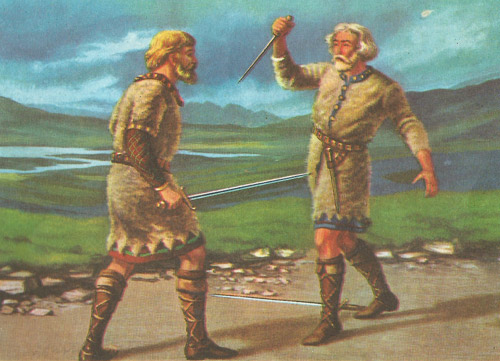Macbeth

Macbeth's fight with Macduff: Lay on, Macduff; And damned be him that first cries, "Hold, enough!"
The curtain rises: thunder roars, lightning flashes, and three witches are seen on 'an open place'. When shall we three meet again?' the First Witch asks, or rather cackles. 'In thunder, lightning, or in rain?' They make an appropriate opening to a play which has an atmosphere charged with evil, images of darkness, and suggestions of the unknown – Shakespeare's Macbeth.
Plot of Shakespeare's 'Macbeth'
Macbeth, a general in the army of King Duncan of Scotland, is rewarded for his valour in a battle against invading Norwegians by being made Thane (similar to Earl) of Cawdor. The grateful king also decides to spend the night at Macbeth's castle. Macbeth has royal blood (he and King Duncan are cousins) and nurses an ambition to secure the Scottish throne. The prospect of having Duncan beneath his roof tempts him to evil thoughts. Goaded by taunts from Lady Macbeth, his equally ambitious wife, he murders the king in his sleep – making the blame appear to be on the king's guards. When the murder is discovered, Malcolm and Donalbain, the king's sons, flee the country in terror of what might happen to them. Malcolm is followed to England by a Scottish lord, Macduff, and persuaded to try to reclaim the Scottish throne from Macbeth who has been crowned king. They win support in England and return to Scotland with an English army to do battle against Macbeth. Macbeth is finally slain, and Malcolm is made King of Scotland.
King James 1 of England
Shakespeare wrote this play in 1605-1606, two years after King James VI of Scotland had succeeded to the throne of England, when he became King James 1 of England (and VI of Scotland). The king was the son of Mary Queen of Scots, and first of the royal line of Stuarts to be King of England as well as Scotland. The theme of Scotland's history was naturally topical in England at that time, and particularly when it connected with the king's own family.
King James was said to be a descendant of Banquo, who appears in the play as a fellow general of Macbeth, and as a man of wisdom and good character. It is likely that Shakespeare chose the subject of his play because of the close connection.
Holinshed's 'Chronicle'
The main, and possibly the only, source of historical information used by Shakespeare was the 1587 edition of a book known as Holinshed's Chronicle, which starts with 'The description on Scotland'. This book contains fascinating stories of the kings of Scotland, and Shakespeare followed it closely. Modern historians have found, however, that it is not very accurate, and contains only the bare bones of fact, to which industrious chroniclers added traditional or imaginary stories which they thought might have happened. It is this fictitious history, built into the framework of fact, which we see on the stage when Macbeth is performed. But it must always be kept in mind that in the days of King James 1 these stories were thought to be history.
What facts can we be sure about? There was a King of Scotland named Duncan, who reigned from 1034 to 1040, in which year he was slain by Macbeth, who ruled for 16 years as King of Scotland until he, too, was slain in battle, and was succeeded by Duncan's son Malcolm. Little more is known as certainty. Although, as we have said, Shakespeare considered his play to be based on history, he made several alterations from his colourful original. Holinshed describes Duncan as a feeble ruler, whereas in the play he is shown as a fine and virtuous old man. This blackens Macbeth's guilt, and makes the murder more dramatic. An important change from the account of Duncan's murder in the Chronicle is that Holinshed described Banquo as an accomplice with others in the deed, which was carried out as an open political assassination. But it would have been very unwise of Shakespeare to show te reigning monarch's ancestor in this bad light.
Very important from a dramatic point of view is the poet's enriching of the characters of Macbeth and Lady Macbeth. Macbeth's hesitancy in the murder (Is this a dagger, which I see before me, The handle toward my hand?) and his wife's evil encouragement (Look like the innocent flower, But be the serpent under't;) were derived from the stories of completely different people in Holinshed's Chronicle, and from Shakespeare's own imagination.
The atmosphere of 'Macbeth'
Apart from the three witches, with their evil prophecies of the events in the play, and Hecate, their mistress, there is a series of ghastly apparitions, including the ghost of Banquo whom Macbeth has also murdered. Here, of course, we are in the realm of fantasy, but a fantasy which is interwoven with the fabric of the play. When the witches say: 'Fair if foul, and foul is fair', they mean that Macbeth, who appears so 'fair' to King Duncan, is contemplating a truly 'foul' deed. So fantasy and history, which modern research has proved to be largely imaginative, have been combined in Shakespeare's play.
